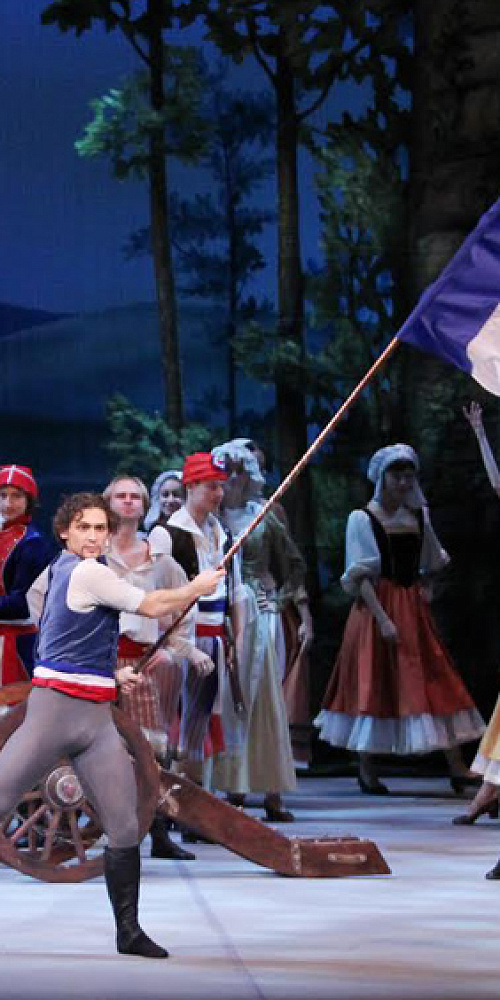Mikhailovsky Ballet — Flames of Paris — New York
After the Bolshevik Revolution, the Russians needed a new, revolutionary art to go with the new political reality. Every cultural activity, from opera to poetry, underwent a thorough re-examination, with sometimes disastrous results: public humiliation, denunciation, imprisonment or worse for artists who failed to achieve the right tone. (Just look at poor Mr. Shostakovich.) But sometimes, as if by a miracle, a group of artists got the formula just right; a work satisfied the censors, became popular and somehow managed to project a glimmer of the new nation’s pure-hearted ideals, elusive as those ideals were. The 1932 ballet Flames of Paris is such a work.
Seeing it performed this week by the Mikhailovsky Ballet – in a slightly revised 2013 version by Mikhail Messerer – is like entering a time machine. Here is ballet as mass entertainment, Sunday double-feature, acrobatic display, musical singalong. Flames of Paris has a little bit of everything: sword-fighting, silent-film acting, clog dances, villains straight out of The Three Musketeers and revolutionary zest to burn. Most of all, it’s a celebration of the ballet company as collective. Everyone shines.The ballet, originally made to mark the fifteenth anniversary of the October Revolution, has a plot plucked from the novel Les Rouges du Midi, by Félix Gras, set during the French Revolution. The music, by Boris Asafiev, draws from revolutionary songs and folk melodies, as well as the music of eighteenth-century court composers like Lully. The main characters are a peasant girl (Jeanne) and a Marseillais revolutionary (Philippe), who meet and fall in love just as the Tuileries Palace is about to fall to the Sans-Culottes. The first scene is set in the countryside; an evil Marquis beats up an old man (Jeanne’s father) for gathering firewood on his property. The second takes place at court, where our villain manipulates the king – with help from the traitorous Marie Antoinette – into signing an unpatriotic treaty with the Prussians. Before you know it, the revolutionaries have overrun the Tuileries. Then everybody celebrates.
If it sounds like the plot of an adventure movie, that’s exactly the point. The libretto, developed by the playwright Nikolay Volkov and the set designer Vladimir Dmitriev, is action-packed. Opportunities for dancing are wedged into plot points. The courtiers minuet, the masses form line dances and swing their partners on the town square. The choreographer Vasily Vainonen – a great innovator at the time but hardly known outside of Russia – finds a way to squeeze in an entire miniature Baroque ballet into the court scene. What’s impressive is the range of styles Vainonen draws upon, from the limp-wristed curlicues of eighteenth-century court dance to the show-stopping leaps and lifts of high Soviet style, folk dancing and everything in between. The facility with which Vainonen slips between idioms is what makes Flames such a joyous, generous entertainment, a ballet with a common touch.
Of course, it’s impossible to see this work with the eyes of a citizen of the Soviet Union c. 1932. Flames makes us laugh and cringe at the same time: I couldn’t help but feel a twinge of pity for poor Marie Antoinette, cluelessly conniving in her towering powdered wig. What hell awaited her! (Luckily we are spared her demise.) This discordance between the ballet’s blithe cheerfulness and the rather more gloomy reality of the reign of terror is surely what led choreographer Alexei Ratmansky to tweak the story in his own 2008 reconstruction of Flames for the Bolshoi. Mikhail Messerer has opted, instead, to play the story completely straight, describing it in an interview as a “great fresco” of the Revolution. Not history, but a kind of colorful and vivid cartoon. Both versions draw on a film version from the 50’s. Messerer also works from his personal recollections of the ballet, which had not been performed since his childhood. Both his mother (the virtuoso Sulamith Messerer) and his uncle (the equally virtuosic Asaf Messerer) performed it many times at the Bolshoi.
But for the ballet to work it has to be danced with conviction and joy, and this is what the Mikhailovsky pulls off marvelously well. Oksana Bondareva, in the role of Jeanne, has a clean, direct, unmannered style. Her turns are spectacular, whether traveling across the stage while whipping off a series of fouettée turns, or polishing off a quadruple pirouette, or spinning with one leg to the side with as much power as any man. (Alas for Messerer, Bondareva has been poached by the Mariinsky.) A Basque dance, full of stomps and marching steps alternating with haunting glides, is proof of how exciting “character” dance can be when done right. The swaying, rollicking clog dance would make Frederick Ashton blush with delight.The Baroque folly, led by Irina Perren, Leonid Sarafanov, and Veronika Ignatyeva (as Cupid), is danced with a great sense of period style – contrapposto, soft elbows, tilted heads – not to mention elegant, filigreed footwork. Sarafanov, who came across as slightly wan in Giselle a few days back, was scintillating here. Perren returned in the final act as half of a heroic duo meant to symbolize one of the ideals of the revolution: La liberté. She burst in, carried across the stage in a one-armed lift by the towering Marat Shemiunov. Her partner was concealed behind a row of men, thus creating the optical illusion that Perren was floating, or perhaps flying. Soviet-style athletic partnering at its finest.
And then there was Ivan Vasiliev, one of the company’s part-time stars. Once again, he delivered his parcel of death-defying feats. Legs thwacking together in the air, double air turns, the by-now-requisite so-called 540 jump in which one leg whips up and over the other while the dancer rolls in space. Vasiliev sat in the air, he lay down in it, he did multiple turning split jumps, sometimes landing on one knee. And in between, he stomped about and flared his nostrils and flashed his eyes at the folks in the upper tiers. Before launching into his solo in the famous Flames of Paris pas de deux – the one part of the ballet that is often performed – he was cheered for simply walking, cowboy-style, to the back of the stage. The guy is a ham with a capital H. But between bursts of flight, he looked disengaged, slightly bored.
No matter. Flames of Paris is proof that not all art is eternal or universal, that sometimes it can be very much of a certain time and place. And that’s a good thing. It was smart of Messerer to revive this ballet for the Mikhailovsky; it’s a calling card and a curiosity, and the company makes a very good case for keeping it around.
By Marina Harss, DanceTabs



